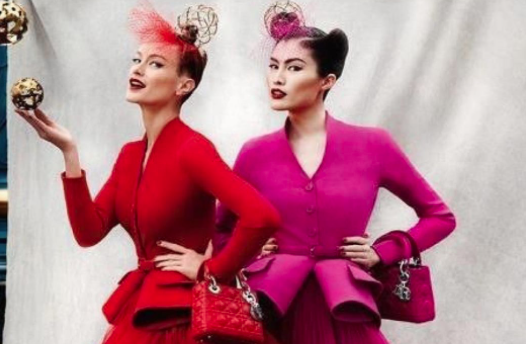Changes in fashion trends are one of the most important fashion rules. Today, the fashion world does not stand still – it is actively changing, reviving the long forgotten styles, and the personalities of the industry are constantly upholding the return trends and ensuring that this style life circle does not break.
Returning to fashion, reborn, resurrected – often in the context of fashion, there are phrases that really make sense.
Every season the must have list includes many standards or styles that have already been in the limelight before. In the past, the old trends usually came back after 30 years, but today, as the pace of life increases, trends are changing faster and returning 20 years after expiration.
Fashion has not always been inspired by the past – the life circle of trends emerged when modern fashion began: when trends and seasonality began to appear on the podium. The beginning of the latter is considered to be the opening of the fashion house of Chanel and the emergence of exclusive sportswear and their brands in the beginning of the 20th century. Here is one of the clearest features on how modern fashion is affected by retro style and the influence of long-standing trends.
Ideas – from history
Having opened big fashion houses, designers have begun to fundamentally change fashion standards and rules. Until then, collections were created with one clear pattern, and the most prominent fashion houses began to look for a clear stylistic direction for their collections to help enhance femininity. One of the easiest options for designers then seemed to choose the silhouette regarded as the perfect femininity in society and adapt it to women who are open to innovation.
Here’s the designer Jeanne Lanvin, who was one of the first to create an 18th century romantic inspired dress in the 1920s. Then she used a torso-widening silhouette, typical of the chosen period, and under the skirt she took on extra material that gave its wearer courage, a modern-looking blast, and extravagance. She adopted such a design decision to revive the forgotten femininity of the First World War.
Christian Dior did the same. In 1947, the designer created and introduced a revolution called the New Look. It was a collection that was inspired by the 1860s – many models were dominated by a narrow-girded bee torso and elegant bust and hips highlighting sexuality. This image gave rise to the cult of the sand clock figure.
Dior’s inspiration for this collection was the women after the Second World War who had worked very hard and lost their gentleness and femininity in the process. He created a kind of an antidote for the modest worker’s style and revived the nobility of femininity. Needless to say, the designer made the clothes very stylish and up to date, making them perfect for modern princesses, and the clothes were more functional and fit for everyday use than in the 1860s.
Shortly afterwards, many of the most renowned designers began to revive old-fashioned trends in their collections, which, with each designer, gained more and more different frames, colors, and features.
As fashion progressed, a rather comical paradox began to emerge – more designers began searching for ideas and style solutions in already forgotten trends. This resulted in the extravagant fashion of the 1970s and the wide shoulders inspired by the silhouettes of a tuxedo of the 1980s. Later, the eighth and ninth decades became one of the greatest sources of trends, and so far the seasons have been feeding us new, but also old, time-tested trends. Therefore, in essence, fashion is an eternal motor driven force that is constantly renewing and bringing back trends we have seen before.
Trends That Can’t Quit Quietly
Among the often returning trends in the style of the eighties and nineties, some patterns never really seem to disappear. Stripes and dots are some of the most common patterns in women’s wardrobes.
These patterns are not a classic, but they are the whimsical and expressive trends that fashion designers and brands are proposing to combine differently each time. For example, small spots are coming back to fashion in one season, and in the other they are big and rare. These patterns are sometimes called classics because they are, unlike rare drawings, a retrograde trend from the 1960s onwards, from absolute classics to elegance. Today, these patterns are also an integral part of elegance, allowing you to diversify and give the most up-to-date look even for an extremely classic combination.
Among the favourite trends, fashion also has a favourite style of shoes, a stilettohigh heel. First they appeared in the sixties and, although having lost their popularity for some time, have since returned to fashion with different roles.
Stiletto’s shoe style is universally suitable for long boots, boots, classic shoes and all other shoes. Also, every time they return with a different height – when a low heel is in fashion, the stiletto can be as high as 5 cm high, and when it comes to the high heels, there is no limit. The long-standing popularity of this trend is also due to the period of its emergence – usually the fifties and sixties are the source of elegance and sophistication, even the perfect femininity. That’s why stiletto-style shoes with different forms of elegance come back to fashion and are suitable for modern women.
Faster and more often
It is easy to notice that the trends fade away and return to the wardrobes faster than ever before. Today, the reversal of trends is influenced by the great pace of both the world and the fashion industry – style bloggers, Instagram opinion makers, and prominent personalities with increasing influence have turned the highest gear to fashion. Trends from the past can become fashionable very quickly – one influential personality’s voice is enough to gain popularity for a particular element of the style and for it to become the next big thing. This is why trends in fashion have recently returned twice as fast – every 15 years.
Moreover, the trend of popularity is fast and expires today. Unlike before, fashion trends on the pedestal today are in for a season or two, but they used to last for a couple of years.
In addition, trends tend to reveal some of the features of different periods of style, so this just proves that fashion has successfully caught up to a new, fast pace of life, and strives for an ever-newer, more comfortable and distinctive style for the rushing society.




